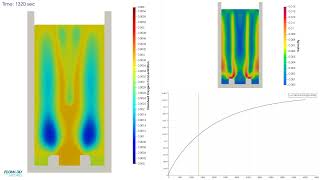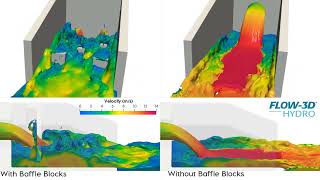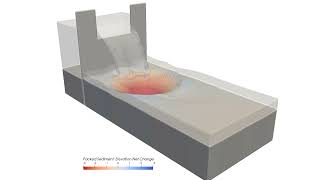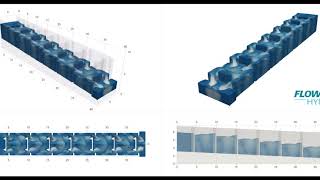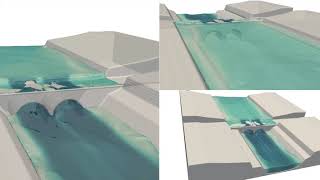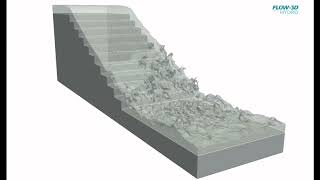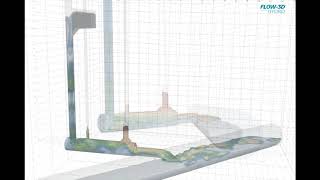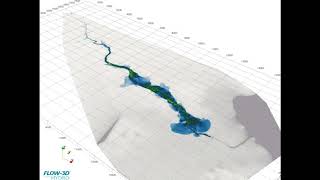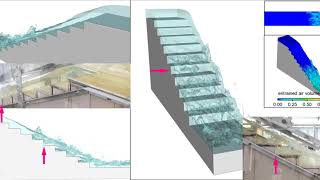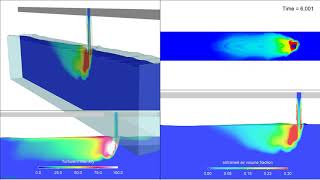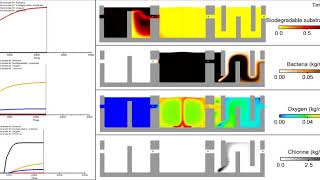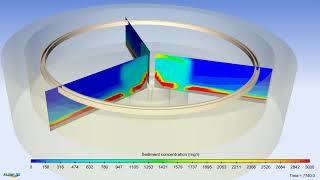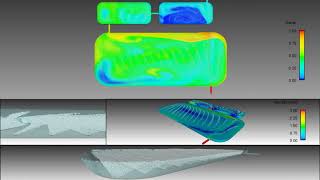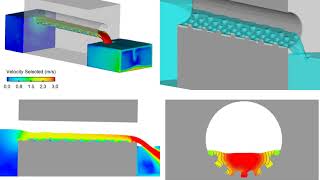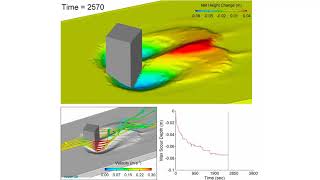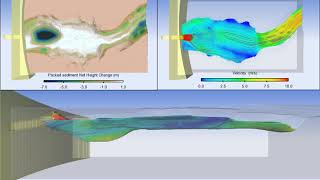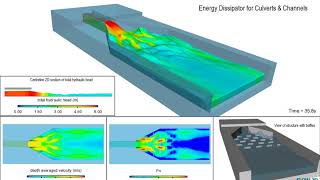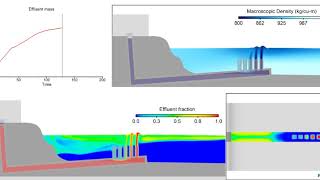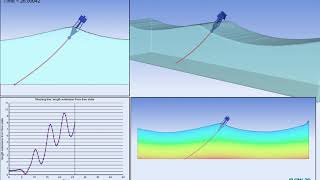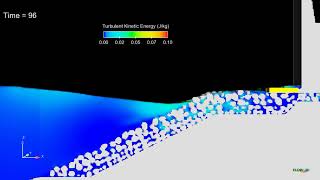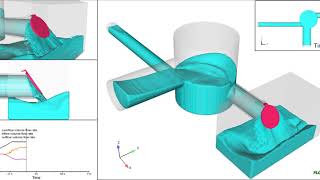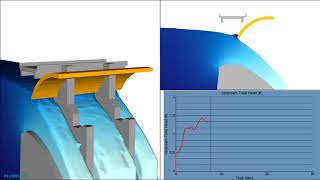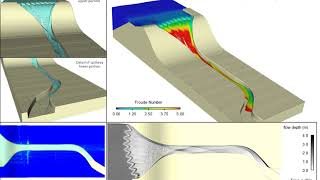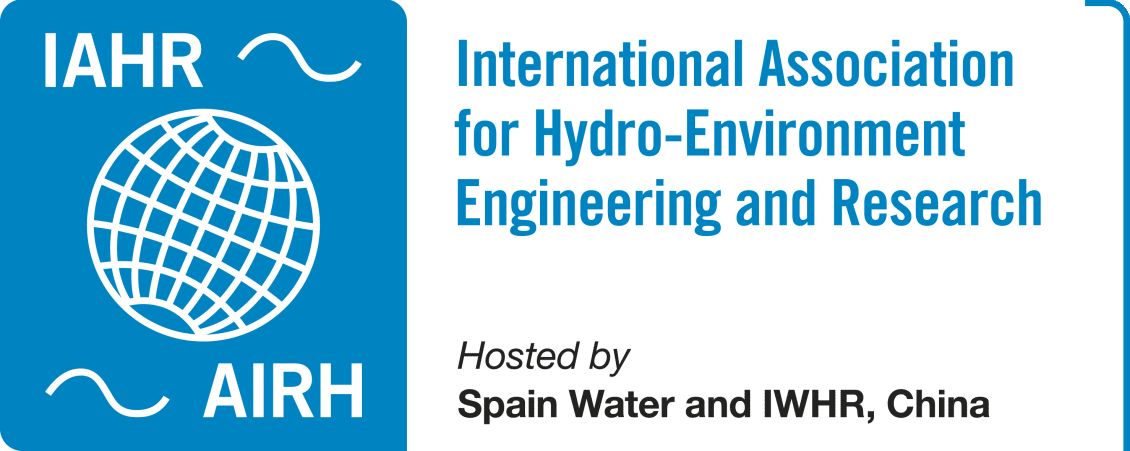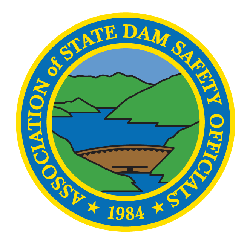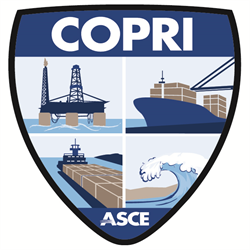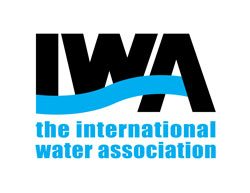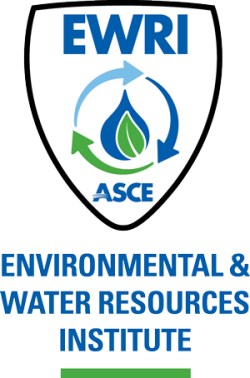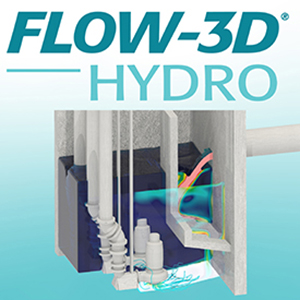FLOW-3D HYDRO is the complete 3D CFD modeling solution for the civil and environmental engineering industry. Powered by the industry-leading FLOW-3D solver engine, FLOW-3D HYDRO is a cutting-edge, integrative solution that puts exceptional simulation capabilities into the hands of engineers and water specialists working to meet 21st century challenges in water resource management and protection. FLOW-3D HYDRO’s highly-accurate free surface solution is complemented by a range of additional modeling capabilities, including air entrainment, sediment scour and transport, tailings flows, and 2D/3D hybrid modeling. FLOW-3D HYDRO is developed for a range of computing environments, from a personal laptop to a high-performance computing (HPC) cluster. Its streamlined, water-focused user interface, simulation templates, and in-depth training and support make this powerful tool accessible to those who are new to 3D CFD as well as numerical modeling experts.
FLOW-3D HYDRO Playlist
The accuracy and robustness of the sharp-interface tracking VOF methods in FLOW-3D have been enhanced by combing them with fluid particles. The new particle species, called VOF particles, are used in place of the VOF function to track small fluid ligaments and droplets in the computational domain, achieving better conservation of fluid volume and momentum.
FLOW-3D’s new axial pump model allows users to mimic the net effect of an axial pump in their simulations. There are two options with respect to the pump behavior. The first option is to prescribe either a volumetric flow rate or a flow velocity through the pump so that the fluid is moved at the specified rate. This option is appropriate when an operating flow rate is provided for the pump. The second option provides a more complete definition of the pump operation based on a pump performance curve.
This example represents a sludge decanter that models a mixture of water and sludge entering a decanter and separating. Water is allowed to flow in and out at the back side of the decanter to maintain a relatively fixed level in the decanter. A sampling volume in the bottom of the decanter is used to measure the amount of sludge captured at the bottom. When the sludge mass in the sampling volume reaches 200 kg, a valve opens to release the sludge. The valve closes when the sludge mass drops below 180 kg.
In this simulation, oxygen bubbles are injected from two diffusers at the bottom of the container and allowed to rise in water. As the bubbles rise, oxygen dissolves into water. The image on the left shows the concentration of dissolved oxygen in water. The image on the right shows the water velocity which is induced by the rising oxygen bubbles.
Viscosity is defined as a function of both solid content (density) and strain rate. In this example a dense fluid region slides down into a quiescent pool which at time zero is layered with a dense settled fluid region and clear water above.
In this simulation of air entrainment at a free surface due to a vertical impinging jet, inclusions of air at the free surface jet contact are entrained into the bulk of the body of water after which they will rise or may also be entrained along with ambient flow. FLOW-3D HYDRO offers different methods to model this process. This particular model uses a 2 phase VOF with LES turbulence, although 1 phase VOF with the air entrainment model in FLOW-3D HYDRO is more commonly used.
Disinfection of water is an important part of wastewater/water treatment processes. One method of disinfection uses chlorine added to the water in a Contact Tank. This simulation models the interactions between chlorine and a pathogen in a contact tank. The simulation first models the hydrodynamics of the contact tank. Then the disinfection process is modelled using a scalar model to represent the chlorine and pathogen and is coupled with a reaction kinetics model to model the consumption of the chlorine and the decay of the pathogen due to disinfection.
This FLOW-3D HYDRO simulation compares the velocities of a culvert outlet with baffle blocks and without. Both models have the same flow exiting the culvert outlet.
A FLOW-3D HYDRO model of waves passing over a series of simple moving objects represents flow through a submerged, flexible coastal canopy.
Save time, avoid mistakes, and run consistent models with FLOW-3D HYDRO’s Workspace Templates. Workspace Templates pre-load fluid properties, physical models, numerical settings and simulation outputs for common applications, including sediment transport. The sediment transport model in FLOW-3D HYDRO can be used to evaluate scour and deposition, where three-dimensional flow components are driving the scouring process.
This FLOW-3D HYDRO CFD simulation uses the Hybrid 3d/Shallow Water model to better understand and more efficiently model bridge hydraulics. The simulation fully couples the 3D model with a 2D shallow water model together in one run. The surrounding areas to the bridge were modelled in full 3D, while the upstream and downstream areas of the river were modelled using a 2D shallow water model.
This FLOW-3D HYDRO simulation shows a scalar concentration of a neutrally buoyant plume modeled using the Large Eddy Simulation (LES) turbulence model.
Hydraulic jumps such as the one shown in this simulation can be engineered to provide energy dissipation at dam outfalls and other structures which would be at risk due to the kinetic energy of the flow. This simulation was created in FLOW-3D HYDRO and post-processed using FLOW-3D POST‘s ray tracing capabilities.
Development of a hydraulic jump simulated with FLOW-3D HYDRO. The top view is a ray-traced rendering of the flow; the bottom view, a 2D slice of the velocity field. This simulation was postprocessed with FLOW-3D POST, our new postprocessor for visualization and analysis across FLOW-3D products.
Rendering of a FLOW-3D HYDRO dense jet simulation, this visualization uses volume thresholds in FLOW-3D POST, Flow Science’s new postprocessor available across all FLOW-3D products.
Baffle drop shafts transport storm water to underground tunnels for storage and transport. FLOW-3D HYDRO can be used to compare drop shaft design elements such as shaft diameter and baffle spacing, which affect the flow velocity, amount of entrained air entrained, and other flow features.
FLOW-3D POST ray trace rendering of a FLOW-3D HYDRO model of an energy dissipating baffled outlet.
Under certain flow conditions tangential dropshaft are effective by promoting the formation of a vortex core in the dropshaft as the flow is propagated to lower elevations. FLOW-3D HYDRO offers multiple modeling approaches to help engineers model free surface flow characteristics, and evaluate the energy dissipation, downdraft and air entrainment behaviors of the system.
This pre-packaged FLOW-3D HYDRO example uses the Free surface – TruVOF template available in FLOW-3D HYDRO for users to quickly setup common free surface hydraulic models. Water properties and all the appropriate models and numerical settings are pre-loaded into the simulation, providing a great starting point to model this vertical slot fishway from setup through to post-processing analysis.
In this example of a self-priming siphon spillway, water flowing through the chute entrains so as to progressively create sub-atmospheric conditions in the siphon. In this example, the Free surface – TruVOF workspace template as well as a second order momentum advection scheme accurately captures the strongly rotational features of the flow.
Culvert capacity and bridge overtopping: as the upstream flow rate increases, the culvert may become pressurized, resulting in a complex hydraulic control made up of a culvert coupled with an overtopping weir flow.
This pre-packaged FLOW-3D HYDRO example of a discharge into a tank uses the Free surface – 2 fluid VOF template available in FLOW-3D HYDRO for users to quickly setup two phase air/water models. Air and water properties, and all the appropriate models and numerical settings are pre-loaded into the simulation, providing a great starting point to model two phase flows, from setup through to post-processing analysis.
Staircase spillways can develop strong surface turbulence and self-aeration characteristics as the boundary layer progresses from the spillway’s surface up to the flow’s free surface. This FLOW-3D HYDRO example uses an LES model for turbulence modeling, as well as a second order momentum advection scheme to accurately capture the strongly rotational features of the flow within the step inner regions.
Tangential drop structures can be modeled using a two-phase 2 fluid VOF approach, or can also be modeled using a one-phase TruVOF solution combined with an air entrainment and dispersed phase modeling strategy. This 3D example uses FLOW-3D HYDRO’s Air Entrainment workspace template, as well as a second order momentum advection scheme to accurately capture the strongly rotational features of the flow within drop structure.
FLOW-3D HYDRO example of flow in a baffle drop structure: advanced free surface modeling capabilities deliver an extraordinarily accurate representation of the flow, even in very complex conditions like those found in a drop structure. Courtesy NEORSD, Wade Trim, and IIHR.
In this example of a dam breach inundation, the flow is modeled using FLOW-3D HYDRO‘s shallow water model.
Tailings breach simulation using FLOW-3D HYDRO‘s tailings model. Variable density layers including water at the very top each have their own rheological properties.
This simulation shows the turbulent intensity and volume of entrained air caused by a vertical jet plunging into a moving cross stream. The air entrainment and transport process actually involves three separate models that work together: the air entrainment model, variable density model, and drift flux models are used to approximate the air entrained at the free surface as well as the motion of the entrained air within the fluid.
This simulation shows the water treatment process in a chlorine contact tank. Probes are used to measure the concentration of bacteria, oxygen, chlorine, and a biodegradable substrate at three points along the flow of water through the tank. FLOW-3D simulation can be used to test the design of a contact tank to ensure enough residence time for proper disinfection and avoid regions where water is allowed to remain in the tank for too long.
This simulation shows sedimentation in a circular clarifier. 2D clips are used to show the profiles of sludge settling at the bottom of the tank. The separation and removal of solids from wastewater through settling tanks like this one is often part of the activated sludge process, following aeration.
Aeration is part of the activated sludge process in wastewater treatment. Air is pumped into the wastewater, allowing aerobic bacteria to digest organic matter and form a floc layer before the wastewater is sent to a clarifying tank. FLOW-3D HYDRO‘s advanced auxiliary models allow water treatment modelers to go beyond the hydraulics of the flow. Grit removal, chlorine contact tanks, sludge settling and aeration all have their own dedicated models and give the user full flexibility into choosing the level of sophistication of their modeling effort.
FLOW-3D HYDRO is the ideal tool for the design and analysis of fish passage structures. Highly accurate 3D simulations of complex free surface conditions provide advanced investigations of upstream passage success through the evaluation of flow velocities, depths, drop heights and turbulence characteristics along potential movement pathways. In this simulation, the flow velocities and pattern are analyzed in a culvert with spoiler baffles.
FLOW-3D HYDRO‘s sediment transport model can be used to evaluate scour and deposition, where three-dimensional flow components are driving the scouring process. FLOW-3D HYDRO’s hydrodynamic model solves the full unsteady non-hydrostatic Reynolds-averaged Navier-Stokes equations that describe the flow physics. All empirical relationships used in bedload, entrainment and settling processes are fully customizable, and up to 10 different sediment species can be defined.
Spillway plunge pools can cause significant sediment scour, which can lead to dangerous conditions at the foot of the dam and undermine the stability of the adjacent slopes. CFD simulations such as the one shown in this video can be used to analyze velocity, air entrainment, tailwater elevation and other spillway characteristics to mitigate sediment scour and other issues in dam safety.
Energy dissipating structures such as the baffles shown in this simulation can be used in some culverts and open channels to limit acceleration of the flow through the channel and help minimize downstream erosion.
Marine outfalls discharge untreated or primary treated flows into a submarine environment. Depending on its makeup, discharge can be either positive, negative or neutrally buoyant, which can affect its dispersion rate. This simulation shows the dispersion of a positively buoyant discharge plume as it exits the outfall.
In this simulation using the moving object model, we can see how wave action affects the position of a coupled-motion floating object — in this case, a moored buoy — and the extension of its single mooring line. FLOW-3D HYDRO can be used to determine the mooring line tension and extension, as well as the overall displacement of the floating structure. Material properties of the mooring lines can be defined for spring coefficient, linear density, and drag coefficients.
FLOW-3D HYDRO can be used in the design analysis of submerged and emerged rubble-mound breakwaters to evaluate wave run-up, reflection, and hydrodynamic forces under different structural and environmental conditions.
In this simulation of a diversion tank, the moving objects model is used to simulate the opening of a sluice gate, which helps regulate the flow of storm water in a combined sewer overflow (CSO) system.
This simulation uses FLOW-3D HYDRO‘s Moving Objects model, which couples solids with the surrounding fluid. The full mass tensor of the ship is needed to accurately characterize the hull dynamic behavior. In this side launch, the ship is released from a standby position to slide down rails before impacting the the water.
FLOW-3D is an industry leader in free-surface flow modeling and is used by dam professionals to address a wide range of design problems for existing and proposed projects. Dam safety professionals and design engineers around the world rely on the efficiency and accuracy of FLOW-3D to easily generate discharge rating curves for complex spillways and control structures. With our advanced free surface modeling capabilities, FLOW-3D HYDRO can be used to simulate flow over a variety of weir shapes and gate-controlled structures.
FLOW-3D HYDRO is an industry leader in free-surface flow modeling and is used by dam professionals to address a wide range of design problems for existing and proposed projects. Dam safety professionals and design engineers around the world rely on the efficiency and accuracy of FLOW-3D HYDRO to easily generate discharge rating curves for complex spillway and control structures. With our advanced free surface modeling capabilities, FLOW-3D HYDRO can be used to simulate flow through complex geometries such as the non-linear weir shown in this example.
FLOW-3D HYDRO simulation results of flow over a weir in a river.
Accurately tracking the species and hydrodynamics calculations can equip wastewater treatment professionals to take quantitatively backed design and operations decisions.
This high definition FLOW-3D HYDRO simulation shows the flow over a flip bucket structure, a common configuration in a side channel spillway.
This FLOW-3D HYDRO simulation shows sediment scour formation and a dune formation for a 2D case. The FLOW-3D HYDRO results are validated against the Chatterjee experiments.
This FLOW-3D HYDRO simulation predicts scour formation around the pier in a flowing river.
In this FLOW-3D HYDRO simulation of a flow over a sharp-crested weir, our state-of-the-art postprocessor was used to illustrate the flow velocity and pressure at the free surface and the flow velocity in a 2D slice (top right). The addition of a flux surface to the model allows the user to report the volume flow rate over time.
FLOW-3D HYDRO Customer Spotlight
How optimized aeration systems can save millions at treatment plants
By Matt Steiner & Jen Murphy for Parametrix
Coastal and storm water management supported through computational fluid dynamics (CFD)
By Andy Collier and Kate Bradbrook for JBA Consulting
How computational fluid dynamics modeling solved aging dam dilemma
By Matthew Hickox for Ayres
Pump Station Will Cut City’s Sewage Overflow, featuring Kleinfelder
By Johanna Knapschaefer
CFD as a tool for “nature-like” fishway design
By Ben Mater for Alden
Combining Computational and Physical Modeling to Design the Keeyask Station
By Efrem Teklemariam, Bernie Shumilak, Don Murray, and Graham K. Holder for Manitoba Hydro
Design Tools for Upgrading Underground Infrastructure in a Congested Urban Environment
By Alison Schreiber, NEORSD; Alan Stadler, Wade Trim; Cathy Findley, Wade Trim; and Sam Glovick, Wade Trim



